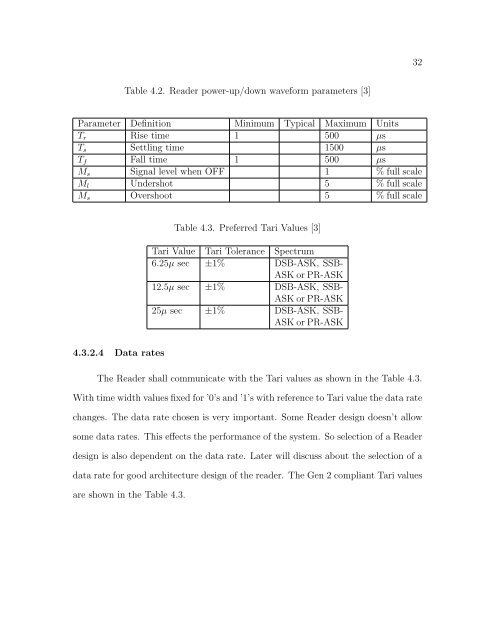BLOCKING READER: DESIGN AND IMPLEMENTATION OF A ...
BLOCKING READER: DESIGN AND IMPLEMENTATION OF A ...
BLOCKING READER: DESIGN AND IMPLEMENTATION OF A ...
You also want an ePaper? Increase the reach of your titles
YUMPU automatically turns print PDFs into web optimized ePapers that Google loves.
Table 4.2. Reader power-up/down waveform parameters [3]<br />
Parameter Definition Minimum Typical Maximum Units<br />
Tr Rise time 1 500 µs<br />
Ts Settling time 1500 µs<br />
Tf Fall time 1 500 µs<br />
Ms Signal level when <strong>OF</strong>F 1 % full scale<br />
Ml Undershot 5 % full scale<br />
Ms Overshoot 5 % full scale<br />
4.3.2.4 Data rates<br />
Table 4.3. Preferred Tari Values [3]<br />
Tari Value Tari Tolerance Spectrum<br />
6.25µ sec ±1% DSB-ASK, SSB-<br />
ASK or PR-ASK<br />
12.5µ sec ±1% DSB-ASK, SSB-<br />
ASK or PR-ASK<br />
25µ sec ±1% DSB-ASK, SSB-<br />
ASK or PR-ASK<br />
The Reader shall communicate with the Tari values as shown in the Table 4.3.<br />
With time width values fixed for ’0’s and ’1’s with reference to Tari value the data rate<br />
changes. The data rate chosen is very important. Some Reader design doesn’t allow<br />
some data rates. This effects the performance of the system. So selection of a Reader<br />
design is also dependent on the data rate. Later will discuss about the selection of a<br />
data rate for good architecture design of the reader. The Gen 2 compliant Tari values<br />
are shown in the Table 4.3.<br />
32
















